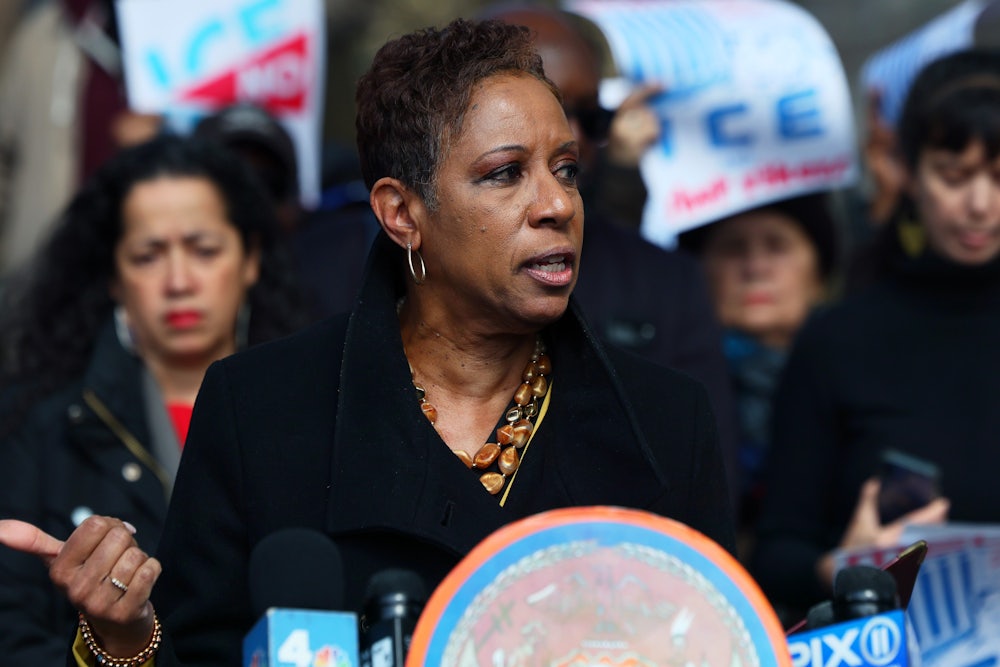Fights over housing in New York City are nothing new, but this month the political antagonism to increasing housing stock and making the cost of living more affordable in general escalated to a whole new level. Instead of the usual lawsuits and procedural slow-walking that usually grind pro-housing efforts to a halt, opponents tried something far bolder: erasing a set of pro-housing ballot initiatives before voters could even see them.
The proposals in question aim to rewrite the City Charter to confront New York’s housing crisis head-on, cutting through the maze of delays that makes building new homes nearly impossible. They’re broadly popular, curbing the power of individual council members to block projects and shortening drawn-out land-use reviews. But opponents found a powerful ally in Council Speaker Adrienne Adams, who pressed the Board of Elections to strike the measures from the ballot altogether, despite the fact that the board had no such power.
The gambit failed, thanks to significant public backlash, but it was striking in how starkly it broke from the usual playbook. Anti-housing forces usually cloak themselves in process: lawsuits, appeals to democracy, endless environmental reviews. As New Republic contributor J. Dylan Sandifer described, it’s a type of proceduralism that provides a “performance of forward motion that, in reality, preserves the status quo.” But in this case, the well-worn pretense was dropped entirely. It was a brazen attempt to subvert both the law and the will of the voters—one that exposed something essential about NIMBYism’s true character.
The standard arsenal of the anti-housing crowd is familiar to anyone who has waded into the land-use wars: Faced with a new housing proposal in their neighborhood, local residents organize a series of delay tactics and clever rhetoric. They hide behind lengthy land-use processes, stressing the importance of community input and control. They weaponize environmental review laws in court. They pack rooms at community meetings, creating a veneer of popular support.
In recent years, especially with the rise of the “abundance” movement, more attention has been paid to the ways these political and legal processes are weaponized to block growth. In turn, the popular discourse has centered around a convenient narrative: Pro-housing activists are the enemies of process and community control, while their opponents are its defenders.
There’s some truth in that, but it misses the deeper reality. As the Board of Elections fight revealed, anti-housing forces aren’t committed to process at all; they’re committed to outcomes. The moment procedure no longer protects the status quo, they abandon it, laying bare how process is not so much a principle as it is a tool of power, to be discarded whenever it fails to deliver the intended results.
Take the saga over Haven Green in Nolita, a plan for 100 percent affordable senior housing on a city-owned vacant lot that city agencies had been pursuing for over a decade. Opponents threw up every obstacle they could, converting the lot into a quasi-public garden, and filing a string of lawsuits, including one that bizarrely claimed the lot qualified for protection under federal laws meant to safeguard historic works of art. They lost at virtually every level. And when the courts and regulators failed to deliver the outcome they wanted, they sought to short-circuit the process altogether, eventually securing a last-minute backroom deal, on the eve of election night, with a scandal-plagued Mayor Eric Adams.
A similar story played out in the Seaport. A parking lot was slated for mixed-income housing, and opponents pulled every lever they could: environmental challenges, landmarks objections, lawsuits that climbed all the way to New York’s highest court. They lost at every turn. Yet instead of accepting the outcome, they pivoted to protests and began accusing local officials of orchestrating a corrupt conspiracy. Having failed within the system, they simply tried to delegitimize it.
These episodes are hardly outliers. When the rules stop protecting the status quo, opponents routinely abandon them without hesitation, escalating the fight beyond law or normal politics. What was once defended as a sacred process, indispensable for democracy and community control, suddenly becomes disposable, swapped out for more audacious, often extra-procedural, tactics.
Pro-housing advocates are often caricatured as market zealots, eager to bulldoze every safeguard in the name of unfettered growth. But this framing fundamentally misunderstands the reality of how these fights play out in real time. Again and again, it is their opponents who lose within the very procedures they celebrate—and then, unwilling to accept the outcome, they turn against the system itself.
This is how power operates in local governance, whether the fight is over housing or any proposal that threatens the current state of affairs. Lawsuits, community meetings, environmental reviews; it’s not that these are inherently democratic or antidemocratic. They are merely instruments, and their meaning comes from how they’re used. Anti-housing forces use them not to ensure valuable deliberation but to obstruct it; rituals of legitimacy that mask the exercise of raw power. Let us take note: These episodes reveal an essential phoniness. Adherence to the rules has become, for NIMBYists, nothing more than a performance undertaken in the name of preserving scarcity and protecting the status quo by any means necessary.
This is a convenient moment to take note of the true colors of those who’ve been standing athwart progress, citing procedure. As our nation’s intellectuals enter the national debate on abundance and growth, we need to reframe the discussion to match what’s happening at street level in our cities and towns. Because there, you won’t find a technocratic dispute over rules and processes, or a clash between defenders of democracy and free-market deregulators. Rather, you will find a struggle over power between those who bend laws and institutions to protect the wealthy and well-connected, and those who demand those laws be put to the use of serving the common good.










